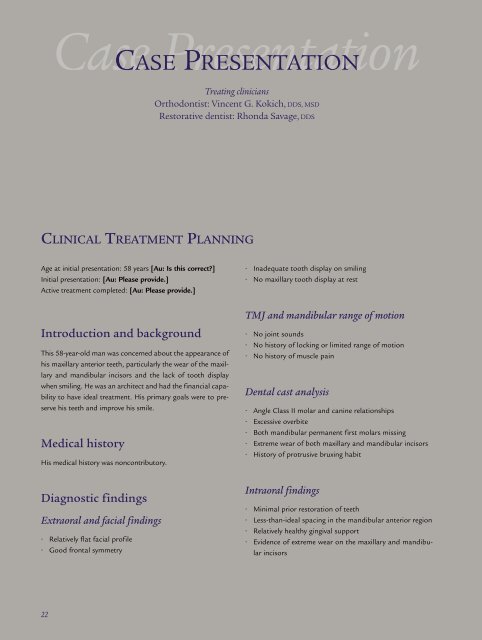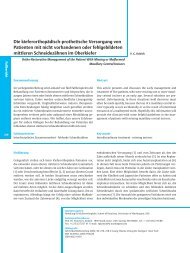altering vertical dimension in the perio-restorative patient - Kokich ...
altering vertical dimension in the perio-restorative patient - Kokich ...
altering vertical dimension in the perio-restorative patient - Kokich ...
Create successful ePaper yourself
Turn your PDF publications into a flip-book with our unique Google optimized e-Paper software.
CASE PRESENTATION<br />
Treat<strong>in</strong>g cl<strong>in</strong>icians<br />
Orthodontist: V<strong>in</strong>cent G. <strong>Kokich</strong>, DDS, MSD<br />
Restorative dentist: Rhonda Savage, DDS<br />
CLINICAL TREATMENT PLANNING<br />
Age at <strong>in</strong>itial presentation: 58 years [Au: Is this correct?]<br />
Initial presentation: [Au: Please provide.]<br />
Active treatment completed: [Au: Please provide.]<br />
• Inadequate tooth display on smil<strong>in</strong>g<br />
• No maxillary tooth display at rest<br />
TMJ and mandibular range of motion<br />
Introduction and background<br />
This 58-year-old man was concerned about <strong>the</strong> appearance of<br />
his maxillary anterior teeth, particularly <strong>the</strong> wear of <strong>the</strong> maxillary<br />
and mandibular <strong>in</strong>cisors and <strong>the</strong> lack of tooth display<br />
when smil<strong>in</strong>g. He was an architect and had <strong>the</strong> f<strong>in</strong>ancial capability<br />
to have ideal treatment. His primary goals were to preserve<br />
his teeth and improve his smile.<br />
Medical history<br />
His medical history was noncontributory.<br />
Diagnostic f<strong>in</strong>d<strong>in</strong>gs<br />
Extraoral and facial f<strong>in</strong>d<strong>in</strong>gs<br />
• Relatively flat facial profile<br />
• Good frontal symmetry<br />
• No jo<strong>in</strong>t sounds<br />
• No history of lock<strong>in</strong>g or limited range of motion<br />
• No history of muscle pa<strong>in</strong><br />
Dental cast analysis<br />
• Angle Class II molar and can<strong>in</strong>e relationships<br />
• Excessive overbite<br />
• Both mandibular permanent first molars miss<strong>in</strong>g<br />
• Extreme wear of both maxillary and mandibular <strong>in</strong>cisors<br />
• History of protrusive brux<strong>in</strong>g habit<br />
Intraoral f<strong>in</strong>d<strong>in</strong>gs<br />
• M<strong>in</strong>imal prior restoration of teeth<br />
• Less-than-ideal spac<strong>in</strong>g <strong>in</strong> <strong>the</strong> mandibular anterior region<br />
• Relatively healthy g<strong>in</strong>gival support<br />
• Evidence of extreme wear on <strong>the</strong> maxillary and mandibular<br />
<strong>in</strong>cisors<br />
22





